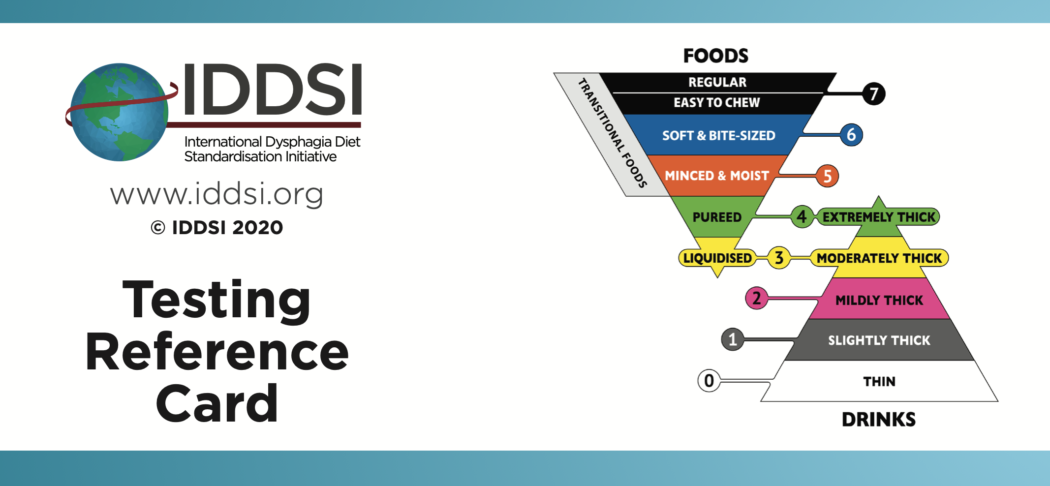IDDSI Framework
Over 590 million people worldwide live with a swallowing disorder called dysphagia2. Dysphagia occurs when an individual experiences difficulty or discomfort when swallowing2. One of the key management techniques for people with dysphagia are therapeutic diets that include texture-modified foods and thickened liquids2. In North America, the varying textures are most commonly referred to as “soft”, “minced”, “pureed”, or “liquidized”, and the beverages “nectar”, “honey”, or “pudding thick”. However, these terms may vary between institutions and are not standardized internationally. This means that the same texture-modified food or thickened beverage can differ in texture or consistency from facility to facility2.
An American task force identified 40 different names used to label solid food and 18 different names to describe thickened beverages1. This can be compared to an Australian study which found 95 different labels used to describe texture-modified food and 12 different names to describe thickened beverages1. This lack of standardization poses potential safety concerns for patients with dysphagia. It also creates confusion for healthcare professionals, researchers, patients, and caregivers.
Research studies utilize different terminology and definitions to describe the dysphagia diet, this makes it difficult to compare study outcomes. If more researchers used the same descriptors for thickened beverages and texture modified food, the ability to compare results would be improved. This would allow for researchers to better determine the therapeutic benefits of the dysphagia diet.
The International Dysphagia Diet Standardization Initiative (IDDSI) began in 2013 to help address the lack of standardized terminology and definitions for dysphagia diets2. This initiative resulted in the IDDSI Framework.
As this is an international initiative, this framework does not include terms such as “nectar”, “honey”, and “pudding thick”, which are commonly used in North America but, not understood worldwide2. The IDDSI selected terms which are understood across all countries and the framework is available in numerous languages. The IDDSI has developed a systematic method for testing texture-modified food and thickened beverage compliance. The texture of food items can be determined using the fork method and the syringe method can be used to evaluate the thickness of liquids. Click on the links below for more detailed information on each of these methods.
http://iddsi.org/framework/drink-testing-methods/
http://iddsi.org/framework/food-testing-methods/
The adoption of the IDDSI Framework is voluntary. However, the IDDSI has selected January 1st, 2019 as their goal date when all Canadian and American texture-modified food and thickened beverage products will use the IDDSI terminology. Many acute care facilities and industry organizations around the world have already implemented the IDDSI Framework. A pilot study conducted in Germany revealed many strategies that can assist with successful implementation of the IDDSI terminology and definitions3. The study suggested that the standardized terminology framework helps to reduce the risk of death by accidental chocking by addressing errors of incorrectly supplied meals3. This offers the organization a benefit in reduced liability3.
It is important to recognize that the adoption of the IDDSI Framework is not without its challenges. For food and drink producers, there is a cost associated with reformatting texture-modified food and thickened beverage products to meet the standards. Research and development is required to change recipes; this can be a lengthy and expensive process. Suppliers must also repackage their products to reflect the new terminology. For example, many North American companies use the terms “nectar”, “honey”, and “pudding thick” to describe their thickened beverages. These product labels would need to be changed to reflect the new IDDSI terminology.
For healthcare institutions that prepare texture-modified foods and thickened beverages in-house, recipes will need to be tested to determine compliance with the IDDSI standards. The additional labor required to test and reformulate recipes could be costly to organizations. Additional time is also required to train staff on the IDDSI Framework, and organizations must overcome staff’s reluctance to change.
It may not be feasible for larger hospitals to make their thickened beverages in-house due to the volume required. For example, many hospitals and long-term care homes outsource their thickened drinks from other companies. These institutions will only be in compliance with the IDDSI standards if the companies who they purchase from follow the framework. Therefore, it is important that food and beverage companies continue the movement towards adopting the IDDSI Framework.
Some food and drink suppliers have already begun using the IDDSI terminology. It has been suggested by the IDDSI board of directors that companies may use dual language during the transition stages. The company’s traditional labeling (such as nectar thick), as well as the IDDSI labeling, would be on the package. This dual-language may make it easier for hospitals to train their staff in the new terminology. Some suppliers are aiming to utilize these transition labels as early as April 2018.
Overall, the standardized terminology and definitions that have been created by IDDSI provide improved patient safety and allow for higher quality research to be conducted. Many organizations are moving towards adopting the IDDSI Framework, however, these changes require time, extensive planning, and budgetary considerations. For the seamless implementation of the IDDSI Framework, it must be adopted by both acute and long-term care facilities, as well as producers of texture-modified foods and thickened beverages.











